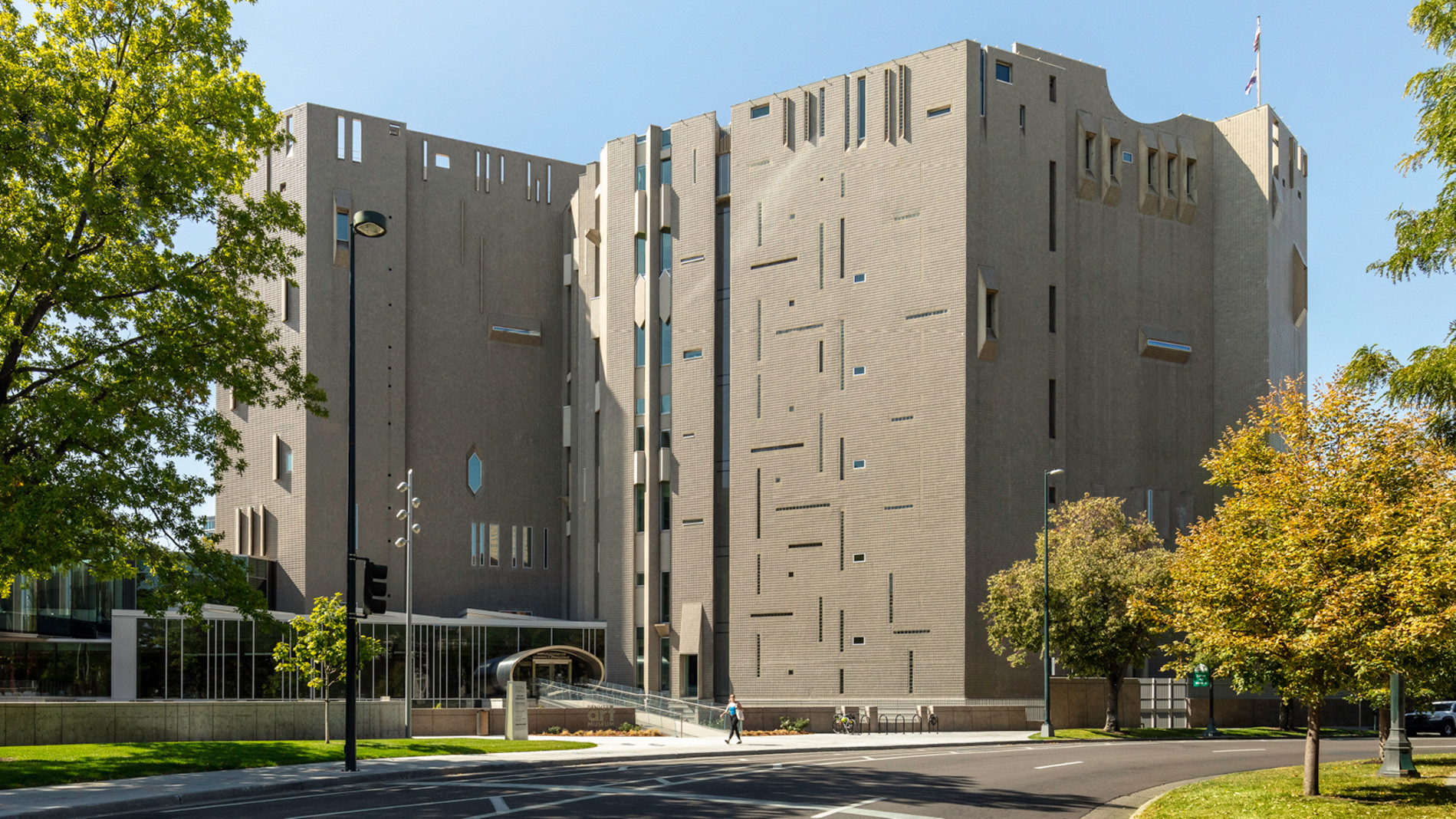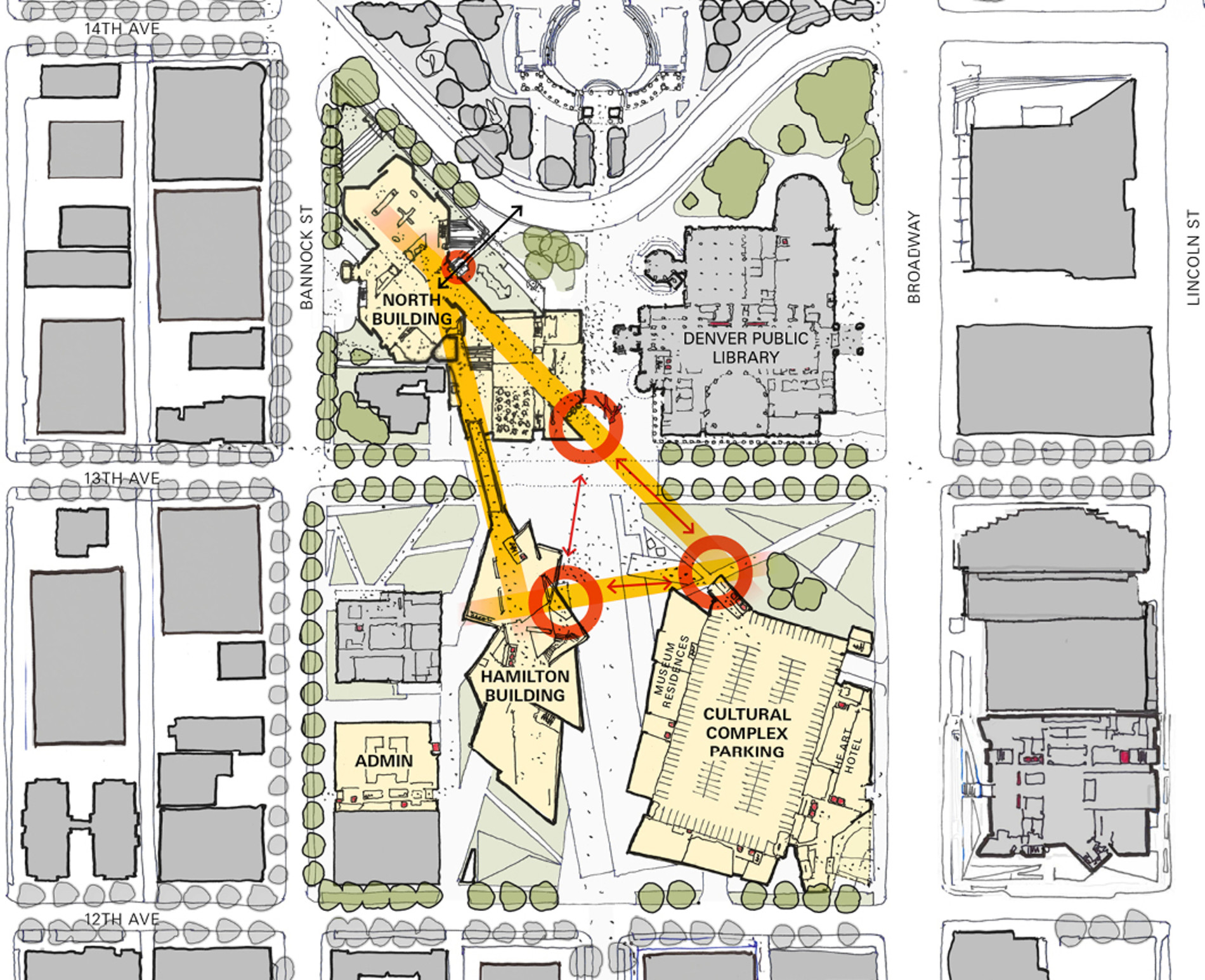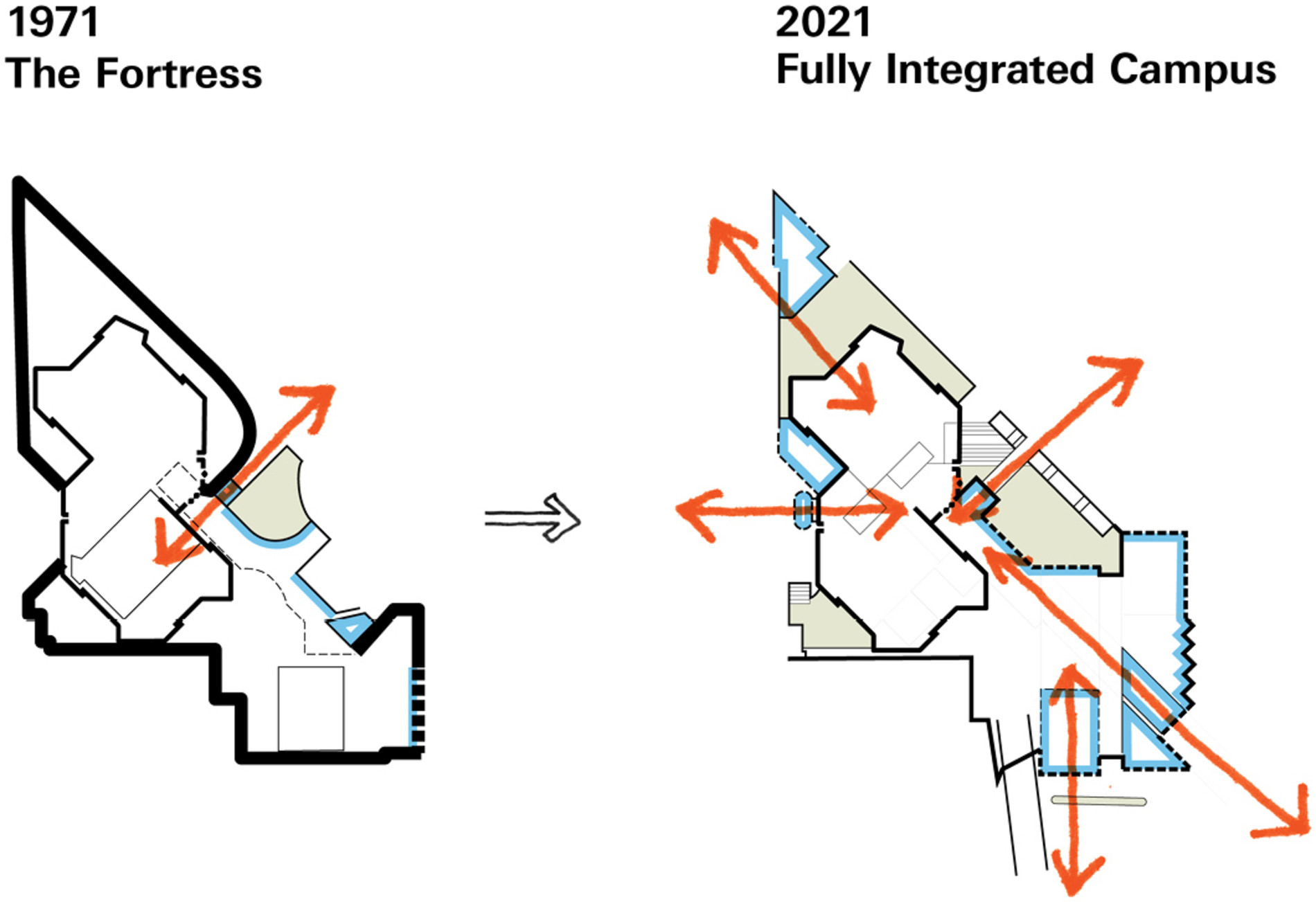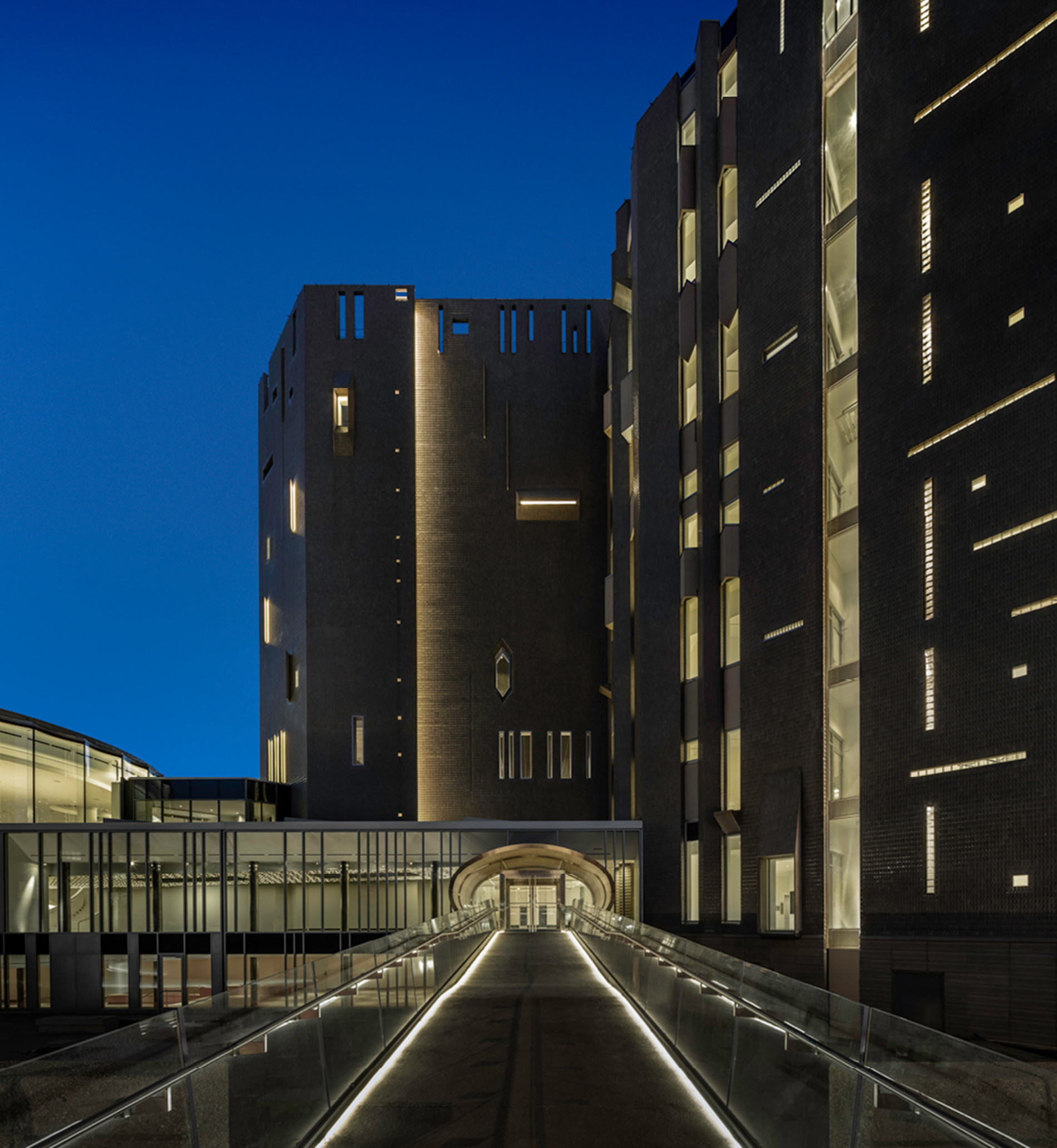
Note: This essay is featured in the Denver Art Museum’s book to mark the reopening of the Lanny and Sharon Martin Building on October 24, 2021.
A PRINCIPLE-DRIVEN MASTER PLAN
Over the course of its history, the Denver Art Museum has navigated changing ideas about its beloved collections, patron requirements, sense of place, message of learning, and how best to present and exchange information. The museum’s collections, buildings, and unwavering mission to “enrich the lives of present and future generations” exemplify a rich history of pushing boundaries that has culminated in the creation of a world-class museum.
The museum’s achievements are tangibly embodied by its two architectural icons: the building by Italian modernist Gio Ponti and James Sudler Associates and the Frederic C. Hamilton Building by Daniel Libeskind and Davis Partnership. When the two buildings opened, in 1971 and 2006 respectively, they each challenged us to think differently about how art is presented and viewed, and transformed the museum’s global reputation. In combination with two outdoor plazas, a parking complex, the museum’s administration building, and the Denver Public Library, these buildings established an eclectic—if somewhat disjointed—cultural campus.

Recent years showed that the museum’s present function and its future responsibility as a cultural institution required thoughtful, comprehensive reconsideration. The Ponti-designed building required restoration and upgrading with an approach that balanced a respect for and stewardship of the past with vision and relevance for the future. The museum saw the need to strengthen ties to the surrounding communities and Denver’s historic Civic Center while further unifying the campus, both architecturally and socially. To address the complexity of these considerations and develop a long-term vision for the site, the museum initiated and engaged in a master planning process led by Tryba Architects.
Tryba, a nationally recognized architecture and planning firm, partnered with the museum to conceive an innovative principle-driven plan to reinvigorate the now fifty-year-old building designed by Ponti and enhance its relationship to the cultural campus and the surrounding city. Completed in 2018, the master plan emerged from four foundational, overlapping principles: stewardship, visitor experience, access and inclusivity, and connectivity. These principles created the conceptual framework for a series of projects conceived to fully align the physical conditions of the campus with its mission and values. Each project was clearly articulated in response to the fundamental architectural elements of site, arrival and entry, circulation, program, structure, and enclosure. Guided by these principles, the master plan facilitated assessment of project priorities and value and provided the basis of the museum’s successful 150 million capital campaign.

STEWARDSHIP
The revitalization of the campus was grounded in the stewardship of Ponti’s iconic design. That responsibility included restoration of the building’s innovative exterior envelope and the replacement and upgrade of obsolete systems. Enhanced building performance and careful reconsideration of the service strategy, gallery configuration, and materials were critical to the continued relevance of the building, its ability to protect and display the museum collections, and its capacity to attract new traveling exhibits.
Deep reflection and study of the museum’s history and legacy brought the potential of the building into clearer focus. Unrealized components in Ponti’s design provided clues to his desire to further enhance and activate the museum’s immediate surroundings while connecting more fully to the landscape of the West. Projects to develop these latent concepts, including an expanded network of active gardens and terraces and a new rooftop pavilion, facilitated a deeper connection to the city, the sky, and the Rocky Mountains.
VISITOR EXPERIENCE
The Denver Art Museum was an acknowledged forerunner in a movement to transform the museum from a secular temple–style container into a more accessible institution centered on viewer choice and access to collections. The radical concept of paired high-rise towers with small floor plans argued that stacked galleries and the elimination of long hallways offered the best viewer experience and promoted choice. But the museum’s idea of effortless vertical circulation was limited by the technology of the day. The master plan revised visitor flow to make movement throughout the building—both vertically and horizontally—more legible, open, and elegant.
The hierarchy and clarity of entrances had become ambiguous as the museum’s campus grew piecemeal over time. The master plan rebalanced the campus, estab-lishing a strong sense of arrival and legible visual axes linking the buildings. The new Anna and John J. Sie Welcome Center integrates visitor services, event spaces, retail space, a café, and a restaurant connected to a new landscaped courtyard. Luminous and glowing at night, this building shines as an integrated and welcoming lantern in the neighborhood.

ACCESS AND INCLUSIVITY
Upon its completion, the Ponti-designed building was dubbed “The Fortress” due to its design, which epitomized a fortified structure—complete with a stand-in drawbridge—safeguarding the treasures and artifacts within from a then-eroding cityscape. Complex social change swept the country during the early 1970s; civil unrest roiled in urban streets across the nation, and Denver was no exception. Vacant lots, car repair shops, a union hall, and bail bonds offices were typical of the neighborhood to the south, east, and west. Ponti’s building walled out this immediate and uncomfortable context, but this architectural proposition was at odds with the museum’s commitment to public engagement and connectivity.
The 2018 master plan envisioned the transformation of this building from a fortress into a beacon that would draw people in and celebrate downtown Denver as an inclusive center of diversity for commerce, creativity, and optimism. The plan proposed to redefine entry thresholds, remove visual barriers to entry, and promote a new openness and transparency that linked the building directly to the landscape of Civic Center. Supporting the museum’s educational mission was also essential. Tryba’s plan emphasized the visual and physical presence of the museum’s internationally renowned learning and engagement program throughout the arrival sequence, galleries, and neighborhood of the revitalized Lanny and Sharon Martin Building.

CONNECTIVITY
The master plan endeavored to reinforce the museum’s connections—physical, visual, and metaphoric—to the visitor, Civic Center, the city, and the world. Urban design, landscape, architecture, and experiential design strategies melded together to advance the plan’s four core principles. An exciting new porosity and flow would transform the museum with level changes, cascades of stairs, bridges, terraces, and overlooks that would bring a heightened sense of legibility, exploration, discovery, and adventure to visitors.
REIMAGINED AND READY FOR THE FUTURE
In its re-energized role as a hub of diversity, creativity, and growth, the Martin Building vastly improves the visitor experience, brings new clarity to the cultural campus, and shows the museum world that an “object building” can be fully integrated into the larger civic realm. The Denver Art Museum master plan process showed that fifty years of investment can blossom into a greater, fully integrated whole, creating a new and memorable cultural experience, reflecting the mission of the institution, serving the public, supporting the staff, and inspiring the community.